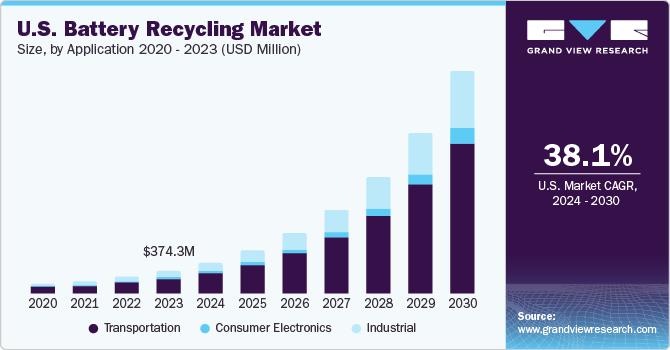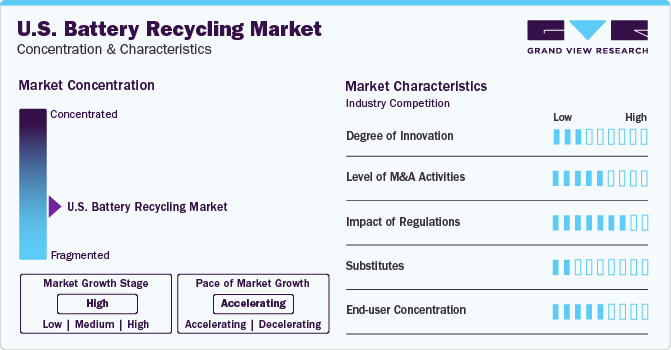
U.S. Battery Recycling Market Size, Share & Trends Analysis Report By Chemistry (Lithium-Ion, Lead Acid, Nickel), By Application (Transportation, Consumer Electronics, Industrial), And Segment Forecasts, 2024 - 2030
- Report ID: GVR-4-68040-220-1
- Number of Report Pages: 80
- Format: PDF
- Historical Range: 2018 - 2023
- Forecast Period: 2024 - 2030
- Industry: Energy & Power
U.S. Battery Recycling Market Size & Trends
The U.S. battery recycling market size was estimated at USD 374.28 million in 2023 and is expected to grow at a CAGR of 38.1% from 2024 to 2030. The major driving factor of the market is the increasing sales of electric vehicles and consumer electronics in the country. The surge in the usage of lithium-ion batteries in smartphones to extend their shelf life and enhance their efficiency is expected to drive the growth of battery recycling market in U.S. in the coming years.

In addition, rising demand for electric vehicles owing to increasing consumer awareness about reducing carbon emissions is expected to fuel the growth of the global battery recycling market, further propelling the growth in the country. Moreover, the decline in demand for lead-acid batteries owing to the implementation of regulations formulated by the Environmental Protection Agency (EPA) to prevent lead contamination of the environment, coupled with the implementation of regulations related to safe storing, disposing, and recycling of lead-acid batteries, has led to a risen demand for carrying out battery recycling activities in the U.S.
The U.S. has emerged as a growing market for the recycling of lithium-ion batteries owing to the presence of large lithium-ion recycling facilities in the country. Increasing sales of electric vehicles in the U.S. owing to the formulation of supportive federal policies such as the Responsible Battery Recycling Act of 2022 California and the presence of leading market players are expected to drive the demand for lithium-ion batteries in the country over the forecast period. The Responsible Battery Recycling Act of 2022 California instructs each battery retailer in the state to have a system for the collection of used rechargeable batteries for recycling and reusing purposes, as well as for their disposal.
Market Concentration & Characteristics
The market is moderately concentrated with the presence of several key players. The presence of strong players is also expected to increase the competition in the future. Since the scope of new product development is pretty low, the competition completely revolves around the price.

The product innovation in the market is moderately low. Companies are investing in R&D to increase profitability and decrease cost. For instance, in April 2022 Call2Recycle announced the battery stewardship and recycling program "OneDrum” along with ERI and Cellblock FCS, which allows customers to transport large volumes of single-use and rechargeable batteries in one container.
Since lithium-ion batteries are classified as miscellaneous hazardous waste, the impact of government regulations is moderate to high. In the U.S., the laws regarding the collection and recycling of batteries vary between states, and only New York and California laws cover lithium-ion batteries. For instance, In California, retailers who sell small, non-vehicular rechargeable batteries must provide consumers with a free system for returning these batteries for reuse, recycling, or proper disposal.
In the U.S. majority of the vehicle batteries are recycled for the reuse. Thus, positive government regulations for the promotion of battery recycling are expected to keep the threat of substitutes low.
Chemistry Insights
The lead-acid segment dominated the market with a revenue share of over 89% in 2023. An increase in automotive sales in the U.S. is expected to drive the market of lead-acid batteries. Thus, the most recycled segment is lead-acid battery segment in the U.S. market for battery recycling. Lead acid batteries are more suitable for recycling compared to other batteries owing to the extensive usage of reusable lead and plastics for their manufacturing. Battery recycling companies collect used batteries from consumers for recycling and reuse. In many companies, the transportation network used to distribute the new batteries is used to safely collect spent batteries from various locations. Some companies have their collection centers or they collect spent batteries from sellers. Spent batteries are taken to a recycling center where they are broken down and separated mainly into three components: plastic, lead, and battery acid.

The lithium-ion segment is expected to witness the fastest CAGR of 38.3% during the forecast period. The usage of lithium-ion batteries is significantly increasing owing to government support for rising number of off-grid installations and growing focus by the private sector, social organizations, and working communities on the improvement of living conditions in rural areas. The absence of grid systems in several remote villages is predicted to create significant potential for largescale lithium-ion battery storage systems for off-grid power supply. Thus, the lithium-ion batteries segment is seeing surge in recycling activities. The recycling process of the lithium-ion battery uses a combination of chemical and physical treatment steps to produce lithium carbonate. The scrape is initially treated by crushing, which further undergoes density and magnetic separation to produce a fine powder. The powder is fed to a hydrometallurgical process consisting of hydrolysis, leaching, and precipitation steps. At the end of the process, lithium is recovered as Li2CO3 and cobalt as cobalt hydroxide.
Application Insights
The transportation segment was the largest application segment in the U.S. battery recycling market with a revenue share of over 66% in 2023. It is also anticipated to grow at the fastest CAGR during the forecast period. Lithium-ion batteries are widely used in electric vehicles owing to the growing awareness about their advantages and increasing fuel prices in the country. This is projected to drive automotive battery recycling owing to the presence of large number of battery manufacturing and recycling companies in the region.Lithium-ion, lead-acid, and nickel metal hydride batteries are extensively used in the transportation industry. Various types of lead-acid batteries such as flooded, and valve regulated types are used as automotive batteries. These batteries are robust, low maintenance, cheap, corrosion resistant, and durable.
Used batteries are broken apart and separated into components before recycling. Recycled lead acid batteries consist of lead, plastic, and electrolyte. Plastic pellets recycled from battery covers and cases are used to produce new covers and cases. Lead recovered from battery grids, lead-oxide, and other parts are used to produce new battery parts, lead oxide, and grids. Recycling of lithium-ion batteries recovers lithium, cobalt, manganese, and nickel which are used in manufacturing of new lithium-ion or other type of batteries. According to the U.S. Department of Energy, sales of hybrid electric vehicles increased by 76% from 2020 to 2021. This is further expected to boost the U.S. market for battery recycling.
Key U.S. Battery Recycling Company Insights
The market is extremely competitive with key participants involved in collaboration and expansion of their recycling capacities. The players are continuously involved in adopting various organic and inorganic strategies to expand their global footprint and recycling capacities.
Key U.S. Battery Recycling Companies:
- Call2Recycle
- Exide Technologies
- Cirba Solutions
- American Battery Technology Company
- Gopher Resource
- East Penn Manufacturing Co.
- Aqua Metals
Recent Developments
-
In November 2023, Redwood collaborated with Toyota to create end-of-life pathways for Toyota batteries used in hybrid and battery electric vehicles. This collaboration aims to maintaincircularity by recycling and reintroducing recovered metals back into battery supply chain.
-
In August 2023, American Battery Technology Company announced the purchase of move-in ready, unoccupied commercial-scale, industrial facility located in the Tahoe-Reno Industrial Center (TRIC). This facility will be dedicated to the recycling of lithium-ion batteries.
U.S. Battery Recycling Market Report Scope
|
Report Attribute |
Details |
|
Market size value in 2024 |
USD 506.16 million |
|
Revenue forecast in 2030 |
USD 3,506.81 million |
|
Growth rate |
CAGR of 38.1% from 2024 to 2030 |
|
Actual data |
2018 - 2023 |
|
Forecast period |
2024 - 2030 |
|
Quantitative units |
Volume in tons; revenue in USD million/billion, and CAGR from 2024 to 2030 |
|
Report coverage |
Revenue forecast, company ranking, competitive landscape, growth factors, and trends |
|
Segments covered |
Chemistry, application |
|
Country scope |
U.S. |
|
Key companies profiled |
Call2Recycle; Exide Technologies; Cirba Solutions; American Battery Technology Company; Gopher Resource; East Penn Manufacturing Co.; Aqua Metals |
|
Customization scope |
Free report customization (equivalent up to 8 analysts working days) with purchase. Addition or alteration to country, regional, and segment scope. |
|
Pricing and purchase options |
Avail customized purchase options to meet your exact research needs. Explore purchase options. |
U.S. Battery Recycling Market Report Segmentation
This report forecasts revenue growth at country level and provides an analysis of the latest industry trends in each of the sub-segments from 2018 to 2030. For this study, Grand View Research has segmented the U.S. battery recycling market report based on chemistry, and application:
-
Chemistry Outlook (Volume, Tons; Revenue, USD Million, 2018 - 2030)
-
Lithium-ion
-
Lead Acid
-
Nickel
-
Others
-
-
Application Outlook (Volume, Tons; Revenue, USD Million, 2018 - 2030)
-
Transportation
-
Consumer Electronics
-
Industrials
-
Frequently Asked Questions About This Report
b. The U.S. battery recycling market was valued at USD 374.28 million in the year 2023 and is expected to reach USD 506.16 million in 2024.
b. The U.S. battery recycling market is expected to grow at a compound annual growth rate of 38.1% from 2024 to 2030 to reach USD 3506.81 billion by 2030.
b. The lead-acid segmented accounted for the largest revenue share of over 89% in 2023 owing to the rising demand in automotive sales in the U.S.
b. The key market player in the U.S. battery recycling market includes Call2Recycle; Exide Technologies; Cirba Solutions; American Battery Technology Company; Gopher Resource; East Penn Manufacturing Co.; and Aqua Metals.
b. The key factors that are driving the U.S. battery recycling market include increasing demand for electric vehicles and growing demand for UPS systems.
We are committed towards customer satisfaction, and quality service.
"The quality of research they have done for us has been excellent."




